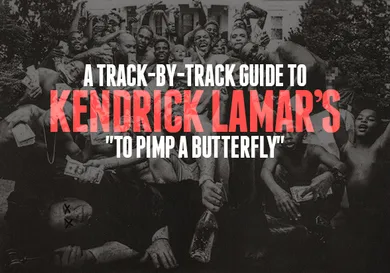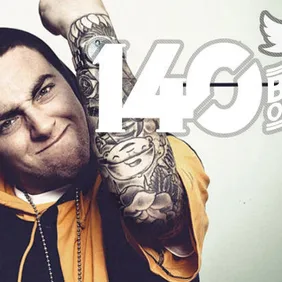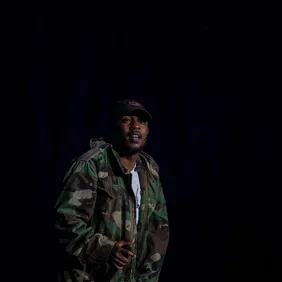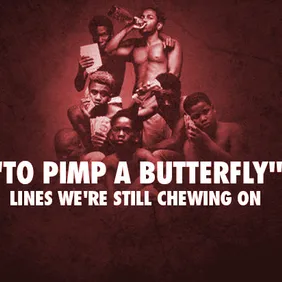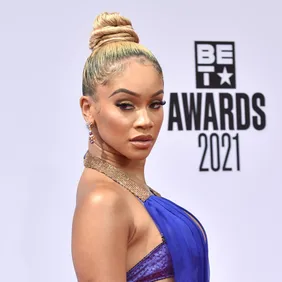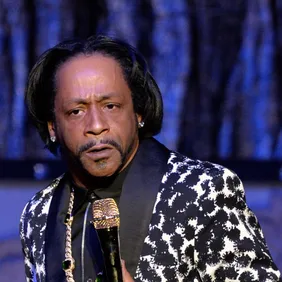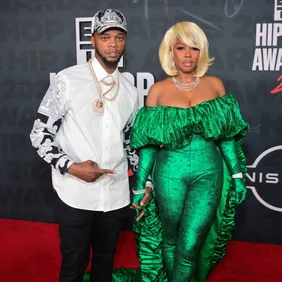Last night, Kendrick Lamar, or someone at Interscope, perhaps, released To Pimp a Butterfly a week ahead of its initial March 23 release date. Already the most anticipated album of the year, Kendrick's follow-up to Good Kid, M.A.A.D. City is unlike anything he's ever done, though it could've only come from the man himself.
Instead of trying to capture any cutting-edge sounds, the album, somehow, throws together decades worth of West Coast music into a cohesive listen. Kendrick surely had a say in every aspect of the album, though a slew of unexpected features, including: Thundercat, Flying Lotus, Snoop Dogg, and Ronald Isley give the album the sort of far-out flavor that we haven't heard since, well, Good Kid, M.A.A.D. City. To Pimp a Butterfly is funkier, more conceptual, more political, and ultimately, more ambitious than its predecessor.
Yes, there is some meaning to be found within the album title. Kendrick Lamar is a truly narrative-focused MC, and TPAB plays like a fully engaging piece of cinema, with a host of unforgettable characters along the way. And Kendrick acts out all the emotions that could possibly occur within his tormented, brilliant soul. Along the way, we hear the many zany voices of K-Dot take shape, and when he raps with soulshaking fury, at times driving himself to tears, the project's authenticity becomes undeniable.
We've put together a track-by-track guide to Kendrick's latest album. Of course, there are countless other details to uncover, but, alas, it's only been out a day.
Your move, Kanye.
cover
Wesley's Theory (feat. George Clinton & Thundercat)
To Pimp a Butterfly begins with a scratchy recording of a man singing, "Every n*gger is a star". The sample is taken from Jamaican reggae singer Boris Gardiner's "Every N*gger Is a Star", off the soundtrack of the 1974 blaxploitation film of the same name.
As the sample fades out, we hear a "hit me!", and P-funk frontman George Clinton begins speaking over a production by experimental L.A. producer Flying Lotus. FlyLo tweeted about his experiences working with Kendrick on the album, which you can read below. Also on the song (and much of the album) is the bassist/producer Thundercat, FlyLo's labelmate.
Clinton's words immediately reference the album title: "When the four corners of this cocoon collide / You'll slip through the cracks hoping that you'll survive / Gather your wind, take a deep look inside / Are you really who they idolize? / To pimp a butterfly." Then, Kendrick begins singing about a woman, saying, "At first I did love you / But now I just wanna fuck." Whoever the woman may be, Kendrick says she was his first girlfriend.
When K-Dot starts rapping, there's no mention of a woman; instead, he details how he wants to soak in all the fame immediately after he blows up, buying everything from Cadillacs to M-16s, and causing a media frenzy in the process.
Three minutes in, we hear a "beep", and Dr. Dre starts to speak, presumably on Kendrick's voicemail: "Remember the first time you came to the house? You said you wanted a spot like mine. But, remember, anybody can get it. The hard part is keeping it, motherfucker."
The song ends with repeated screams of "Tax man comin'!" We're off to quite a start.
Now that the word's out. I produced @kendricklamar "Wesley's Theme" ft. @Thundercat and @george_clinton #topimpabutterfly album is a classic
Wesley's Theory
I played him a folder of beats that I was keeping close for my next @xCaptainMurphyx project. Gave him all the beats like fuxk it.
Later that night he told me he had the concept for the album.
He gets no credit for being a producer but he had a vision for this album. Dude gets involved w the whole process.
Sad thing about that folder of music is I heard he recorded to every one of those songs. Probably never gon hear those. Ooof
When I played him that beat he asked me who I imagined on it. I laughed and said @george_clinton . I never thought it would actually happen
That's already a dream come true
This fool @Thundercat is pretty much on the entire album. 🌟🌟🌟🌟✌️😭✌️
"For Free? (Interlude)"
This jazzy interlude starts with an unnamed woman talking down to her man, saying "You's a off-brand ass nigga, everybody knows it ... My other nigga is on, you off."
Kendrick then proceeds to rip out a poetic stream of consciousness capped off by the phrase "This dick ain't free," which he repeats throughout his freewheeling rant. The song ends with the same woman saying, "I'mma get my Uncle Sam to fuck you up."
"King Kunta"
The third track starts off with Kendrick rapping, "I got a bone to pick" over a funky-as-hell bassline. Kendrick is King Kunta, named after the slave whose life inspired the novel "Roots," which later became a TV miniseries in the late 70s.
"Everybody wanna take the legs off him, Kunta / Black man taking no losses / Bitch where was you when I was walkin'? / Now I run the game, got the whole world talkin', King Kunta / Everybody wanna cut the legs off him."
The above lines touch on Kendrick's status a Black superstar, at once a King and a slave. When Kunta Kinte was captured during an attempted escape, his capturers made him decide between castration or the loss of his foot. He chose his foot. Kendrick is saying people only want a piece of him now that he's "running" the game. No one noticed him when he was a poor Black kid in Compton.
The song closes with the beginning of a speech we'll hear many more times throughout the album: "I remember you was conflicted / Misusing your influence."
"Institutionalized" (feat. Bilal, Anna Wise & Snoop Dogg)
"Institutionalized" is the first of two consecutive songs featuring Bilal and Anna Wise. Bilal has featured in soulful hip-hop collaborations throughout his near 15 year long career, and Anna Wise sang on "Real", off Good Kid, M.A.A.D. City. Also here is Snoop Dogg, who needs no introduction.
Kendrick touches on the song's title during the intro, when he raps, "I'm trapped inside the ghetto, and I ain't proud to admit it / Institutionalized, I keep runnin' back for a visit."
Kendrick ends his first verse, saying, "I should've listened to what my grandmama said to me," which Bilal sings for him: "Shit don't change until you get up and wash your ass nigga."
Then, Snoop proceeds to tell a little story about (presumably) a young Kendrick: "And once upon a time in a city so divine called West Side Compton / There stood a little nigga, he was 5 foot somethin' / God bless the kid, took his homie to the show, and this is what they said."
He continues the story in the song's outro: "Dazed and confused / Talented but still under the neighborhood ruse / You can take your boy out the hood, but you can't take the hood out the homie / Took his show money, stashed it in the mozey wozey / Hollywood's nervous, fuck you, goodnight, thank you much for your service."
Shot out to t Martin n k dot. Great Albulm from top to bottom. Bac to the basics. 📟💽✨🌟🎥. We… https://t.co/J8A3V30UBp
"These Walls" (feat. Bilal, Anna Wise & Thundercat)
Kendrick repeats the first two lines of the speech he ended "King Kunta" with, and continues: "...Sometimes I did the same"; Kendrick admits he's been guilty of misusing his influence. Then we hear a woman start to moan while Kendrick repeatedly whispers "If these walls could talk." Right as the beat drops, Anna Wise emphatically says the word "sex," giving us a clue to the moaning we just heard.
As Anna Wise begins singing the bridge, it's obvious this is a song about sex, and Bilal follows her lead with an incredibly seductive hook, singing, "If these walls could talk / I can feel your reign when it cries, gold lives inside of you / If these walls could talk / I love it when I'm in it, I love it when I'm in it." The "walls" here both refer to the bedroom walls, but, more literally, the walls Kendrick feels when he's inside a woman. What would a woman's body tell Kendrick during intercourse?
Kendrick continues the powerful sexual imagery in his first and second verses, but in the third verse, the "walls" come to signify an enclosed prison cell. Here, Kendrick is speaking to a particular inmate, the man who killed Kendrick's homeboy in front of his eyes, who was arrested the same night. Kendrick echoes the paranoia that will inevitably creep into his psyche as he spends more and more time in prison. He then asks the inmate to rewind back to the first verse, "About me abusing my power so you can hurt / About me and her in the shower whenever she horny ... About her baby daddy currently serving life / And how she thinks about you until we meet up at night."
So, Kendrick has been involved in a relationship with the baby mother of the man who murdered his friend. To the woman, Kendrick is a temporary solution to alleviate a longstanding wound. Kendrick hopes her man realizes that his woman is now "fucking on a famous rapper," but as Kendrick conjures feelings of sweet revenge, he realizes the only person he can confer this new position of power unto is his enemy's brokenhearted baby mother, within whose walls he knows he's "just a tenant."
He then finishes the speech heard at the beginning of the song: "...Abusing my power full of resentment / Resentment that turned into a deep depression / Found myself screaming in a hotel room."
"U"
The song starts with screams, presumably the same hotel room hysteria that Kendrick documented moments ago. Then, in the midst of a breakdown, he shouts, "Loving you is complicated!" eight times before he begins rapping. Kendrick isn't talking about the woman from "These Walls," though; he's speaking to himself.
"U", judging by its one-lettered title, is a companion piece to "i". Whereas during "i", Kendrick experiences the peak of self-confidence, "u" is the epitome of self-deprecation. Kendrick's conscience is carrying out total self-destruction, as he raps, "Numbers lie, too, fuck your pride too, that's for dedication / Thought money would change you, made you more complacent / I fuckin' hate you, I hope you embrace it."
Midway through the song, we hear a Housekeeping woman knocking on the hotel room in which Kendrick's having his breakdown. He doesn't answer.
Now, Kendrick is at rock bottom, literally crying during his second verse, and he's never sounded more believable. He airs out all of his worst fears, including feelings of guilt (missing the chance to visit a friend on his deathbed) and, ultimately, suicide: "And if I told your secrets / The world'll know money can't stop a suicidal weakness."
"Alright"
On "Alright", we get a hook from Pharrell Williams, though he isn't credited on the tracklist. Williams is also a producer on the track. After the breakdown on "u", Kendrick reassures both himself and the entire Black community that "We gon' be alright."
We are soon introduced to the character "Lucy," who will play a pivotal role in the remainder of the album. Lucy is some kind of temptation. As Kendrick gets bigger, so does Lucy; "ain't a profit big enough to feed you." At the end of the song, we learn Lucy was the cause of Kendrick's near hotel room suicide. Thus, he adds to the poem: "...I didn't wanna self destruct, the evils of Lucy was all around me / So I went runnin' for answers."
"For Sale? (Interlude)"
The albums second interlude, a follow-up to "For Free?" A blissful melody unfolds in spite of Kendrick's heavy breathing in the background. Then, we hear a voice, sounding at first like a saving grace, though soon too inebriated to be anything positive. "What's wrong nigga?" says the voice, "I thought you was keeping it gangsta? They say if you scared go to church, but remember, he knows the Bible too." Could this be Lucy, again?
Though we knew Lucy embodied some sort of temptation, we now see that he (male voice) is shaping up to be a Devil-like character. Indeed, Lucy could be short for "Lucifer." Next, Kendrick starts singing, though this is still the voice of Lucy: "Now baby when I'm riding here I'm riding dirty / Smoking lokin' the potion you can see me swerving / 'Cuz I (want you)."
In his only verse, speaking in first person, Kendrick tries to fight Lucy's allure: "You said Sherane ain't got nothing on Lucy / I said you crazy / Roses are red and violets are blue, but me and you both pushing up daisies if I (want you)." Sherane is a former girlfriend who Kendrick mentioned often on Good Kid, M.A.A.D. City. At times, Lucy's grasp is strong--stronger than a woman's love--though K-Dot knows it'll be his demise if Lucy ultimately takes hold of him.
Again, Kendrick ends repeating the words we first heard at the end of "King Kunta". This time, he finishes the poem: "... The evils of Lucy was all around me / So I went runnin' for answers / Until I came home."
"Momma"
"Momma" slows down the rollercoaster emotional ride we've been on, and gets back to Kendrick spitting introspective stop-start bars, constantly mixing up and connecting disparate syllables. He first raps about the competition-fueled highs he experienced while rising atop the rap game: "This feeling is brought to you by adrenaline and good rap." The same hunger, which can be a wonderful feeling, has also alienated him from his life before rap, still an essential part of who he is. But, as Kendrick revealed at the end of "For Sale?", he's returned home. Rap got him out of the hood--"got me a plaque / But what's better than that? The fact that it brought me back home."
And home has been waiting, with open arms, for Kendrick to finally reach this stage of his development. Ultimately, Kendrick's journey home, whether to Compton or on a more spiritual level, is a lesson in humility. It was his knowledge that allowed him to become successful and what barely got him through his severe depression, when Lucy was at his doorstep. Though, the ultimate knowledge, birthed upon his homecoming, is "Not to ever forget until I realized I don't know shit / The day I came home."
In the next verse, Kendrick visits a younger version of himself, and, though worried fame has tainted his perspective, gives the kid one piece of advice: "But if you pick destiny over Rest In Peace / Then be an advocate / Go tell your homies, especially, to come back home."
"Hood Politics"
"Hood Politics" starts with a guy who we presume to be a childhood friend leaving a voicemail for K-Dot, speculating if he's been on "some weirdo rap shit"--some "No socks and skinny jeans shit." His homie must think he's forgotten the street code. He hasn't. And, as Kendrick will demonstrate, the politics haven't changed.
K-Dot goes on to explain the localized gang politics in Compton ain't no different than what we see on the national level: "Ain't nothin' new, but a flow of new DemoCrips and ReBloodlicans / Red state versus a blue state, which one you governin'?" Drugs and guns were given to the hood by those in power, creating an endemic that fuels their own jobs. The President, like everyone else, is just repping his own set: "No condom when they fuck with you / Obama say, 'What it do?'"
Kendrick knows the rap-game politics well, too. Those who lament the present day lack of "rapper's rappers" are looking in the wrong places. If people actually cared, "Killer Mike'd be platinum." As if K-Dot doesn't embody the renegade rapper who's been elevating the genre since its inception: "I'm the only nigga next to Snoop that can push the button / Had the Coast on standby." The only rapper who, with one verse, can "fuck up the game," quoting Jay Z's "Imaginary Player".
At age 14, Kendrick was was in the hood "with the deuce deuce / 14 years later going hard, like we used to / On the dead homies." Fourteen years ago this past Saturday (March 14), 2Pac, still in prison, released Me Against the World. On "Young Niggaz", 2Pac spits, "Told my momma if I did die, just put a blunt in my casket / Let me get my dead homies high." Fourteen years later, regardless of where Kendrick finds himself in the industry, he's still doing it for his dead homies.
Sincere thanks. Salutes @kendricklamar. #RTJ
"How Much a Dollar Cost?" (feat. James Fauntleroy & Ronald Isley)
That's the question Kendrick asks right away, one that's been "paralyzin' my thoughts." It's a question he fully confronts when he thinks back to an encounter he had with a homeless man. Kendrick was unwilling to give the man a dollar because he suspected the man an addict. He also didn't want to give up his dollar.
After a hook by neo-soul crooner, and head of the production team 1500 or Nothin', James Fauntleroy, Kendrick returns to his story, with tensions building between Kendrick and the beggar. After staring at Kendrick to the point of inducing rage, the man asks, not for a dollar, but "Have you ever opened up Exodus 14?", the Bible chapter in which Moses parts the Red Sea and leads the Israelites to freedom.
The man's message, whatever it may be, doesn't immediately reach Kendrick. He continues to hold on to his dollar, realizing his selfishness, and dedication to his own hustle, is what got him here. When he tells the beggar "Every nickel is mine to keep," the man reveals his Bible reference wasn't all for show. He tells Kendrick exactly how much a dollar costs: "The price of having a spot in Heaven, embrace your loss, I am God." Big mistake. Kendrick knows there's no 100 percent real-world answer to this question, but once you start asking, the stakes become Heaven and Hell. By allowing money to be the measure by which Kendrick judges his fellow man, against himself, he displays a complete loss of faith.
For the outro, K-Dot recruits an Isley Brother, Ron Isley, to ask forgiveness. It's a spellbinding finish.
"Complexion (A Zulu Love)" (feat. Rapsody)
The "Complexions" Kendrick is talking about here are all the varied skin tones that can possibly be found within the Black race. Historically, these differences, due to systematic racism, have put Black man against Black man, though Kendrick sings, "Complexion don't mean a thing." Kendrick first plays a slave and says he's picked a cotton flower for his lover. Due to his complexion, and her's, Kendrick is in the field while his woman is in the house, but Kendrick doesn't care, even if the master's listening: "I got the world's attention."
It's Kendrick's mission to put the "Willie Lynch" theory to rest. Lynch was a slaveowner who claimed the way to control one's slaves is to pit them against one another, creating factions based on different complexions. After Kendrick declares his universal love for Blackness, he hands the mic over to a close friend, female MC Rapsody.
Rapsody put K-Dot on a track back in 2011, and we wonder why we haven't heard more from her since. She recounts how she overcame the days when she was embarrassed by her skin color as a young girl. Her message of Black solidarity extends to other colors, such as blue and red, and the gangs associated with each: "We all on the same team."
"The Blacker the Berry"
The harder flipside to the "i" coin, “The Blacker the Berry” is best understood as the Malcolm X to “i”’s MLK, as suggested by TDE’s Punch on Twitter. Boi-1da provides a fittingly militant beat, and Assassin’s fiery hook is enough to make your blood boil. Some additional production flourishes are tacked onto the single version, namely some haunting backing vocals and stadium-sized synths that add to the song’s huge feel.
Like “Complexion” immediately before it, “The Blacker the Berry” focuses on skin color, turning it into a rallying point for Kendrick’s pride and disgust at many of the powers that be. He also turns the hatred inward, now famously calling himself “the biggest hypocrite of 2015” for mourning Trayvon Martin while also being responsible for a black man’s death himself. For a song that’s about as close to a "banger” as we get on TPAB, it’s highly conflicted and confrontational, featuring some of Kendrick’s most vicious rapping on the album.
In the context of the rest of album, the lines from “The Blacker the Berry” that stand out the most are actually Assasin’s, with his use of the word “whip” as a scarring weapon and a luxury car playing into the overarching connections made between slavery, civil rights, and hip-hop. While he’s mostly focused on the rap game for the rest of TPAB, here Kendrick pulls back to confront the historical and societal factors that put him where he grew up, saying that although most of his focus is on hip-hop and its fans, there are bigger things at play here.
We coast out to a jazzy interlude composed by Terrace Martin, setting the scene for the less aggressive three tracks that close the album.
"You Ain't Gotta Lie (Momma Said)"
After “How Much A Dollar Cost”, this is the second song on the album produced by the relatively unknown LoveDragon. Previously working on songs with TDE’s SZA, the beatmaker keeps TPAB’s organic vibe rolling with a tight, live-sounding drum beat, swirling keys, and guitar swells. Terrace Martin was also involved in writing this one, and Thundercat contributes vocals.
Lyrically, Kendrick focuses on the lack of truthful content in modern hip-hop, with his viewpoint best explained by the hook: “You ain’t gotta lie to kick it, my nigga.” He’s not dissing anyone specific here, but does call other rappers “circus acts,” a “parody” and “fugazie,” and invokes the saying “the loudest one in the room is the weakest one in the room.”
Like much of the rest of the album, Kendrick directly addresses his fellow members of the rap game and asks them to examine the irony and insecurities at play in their music. It seems like he thinks rap as a whole would improve if people focused on telling their own stories and didn’t bother with posturing or trying to fit in by rapping about plugs, jugging, burners, and hoes.
"i"
Shared with some notable differences from its single version, “i” is a change of pace from most of the album. It focuses on uplift rather than anger, and features the most recognizable sample on the project, namely The Isley Brothers’ “That Lady”. This time around, "i" sounds more rough around the edges, with harder drums, more distorted rapping and some background noise giving it a live performance feel. This factor, along with an extended runtime, allows Kendrick to give the song more grit than the Grammy-winning previous version.
With the music abruptly cutting off after the more aggressive third verse, Kendrick then speaks as if he’s addressing an unruly crowd, telling them to cut out the shit they’re interrupting his music with. Although it’s under the guise of a concert scene, the track’s second half seems to speak to people’s initial reaction to “i”. “We could save that shit for the streets,” Lamar says, “This for the kids, bro.” Speaking out against the “petty” concerns of hip-hop fans, he directs the audience’s attention to more pressing issues in the black community, namely police violence.
Getting “back to the show,” Kendrick then delivers an a cappella verse in which he struggles with the N-word, specifically the term “fuck nigga.” Saying that people using this term are no better than “Samuel on Django” or “a white man with slave boats,” he then dedicates the verse to Oprah, who’s come out against the use of the word on many occasions. Never one to raise a problem without offering a solution, Kendrick posits that “negus,” an old Ethiopian term for a king, should have been the term that arose out of the derogatory word “negro,” not the N-word as we know it. He concludes by calling himself “the realest negus alive."
"Mortal Man"
The marathon-length, spoken word-inclusive closing track has been a staple in hip-hop since Kanye West told us his life story on “Last Call” in 2004. Last year, we saw J. Cole do something similar with “Note to Self” on 2014 Forest Hills Drive, and now Kendrick joins their ranks. Like “Last Call” and “Note to Self” before it, “Mortal Man” represents the general theme of the album it’s included on. Musically, lyrically and philosophically, To Pimp a Butterfly has Kendrick trying to connect with his forbearers in the Black community, which he does literally in the album's concluding moment.
The song kicks off with James Fauntleroy and Javonte’s voices swirling around a piano line, horn swells, and yet another fluid baseline from Thundercat, before a sample of drums from Houston Person’s cover of Fela Kuti’s “I No Get Eye For Back” heralds Kendrick’s presence. He begins by addressing his fans, or “army,” by asking them if they’ll still be fans “when shit hit the fan." He goes on to ask for the same type of love and reverence shown to Nelson Mandela, justifying this by saying, “I freed you from being a slave in your mind.”
The next verses ask questions of K-Dot’s audience, tell of his trip to South Africa last year, and place him alongside other leaders such as Huey Newton, JFK, Moses, and Michael Jackson. Kendrick admits he questions his relationship to everything he encounters in his life (even “cats, dogs, trees, plants, grass,” etc.), and thus, he’s got a lot of them at this critical juncture of his career. The main one, though, is this: Are his fans willing to go to war for him, or are they just here to nod their heads to the beat and move onto the next rapper?
As the music transitions to more orchestral sounds, and then fades out, he begins a spoken word piece before simulating an interview with perhaps Kendrick's biggest idol, Tupac Shakur. Kendrick splices himself into a recording of a 1994 interview, replaces the interviewer, and hears Pac speak of revolution, fighting resistance with resistance, and the power of music, to which Kendrick responds with a poem. This, the last thing we hear on the album, is where the title really factors in. His metaphor of caterpillars and butterflies can be interpreted a number of ways, but it frames “pimping a butterfly” as similar to "killing a mockingbird," an act that author Harper Lee uses as a sinful metaphor in “To Kill A Mockingbird.” Whether the two stages of the same creature represent reality versus potential, civilians versus celebrities, or people living in “the hood” versus people who made it out, Kendrick’s message is clear: Mutual understanding is the key to freedom. It’s a powerful, theoretical ending to a dense album--one that will take multiple listens to fully grasp--and it’s where Kendrick comes out and makes his definitive mission statement.
